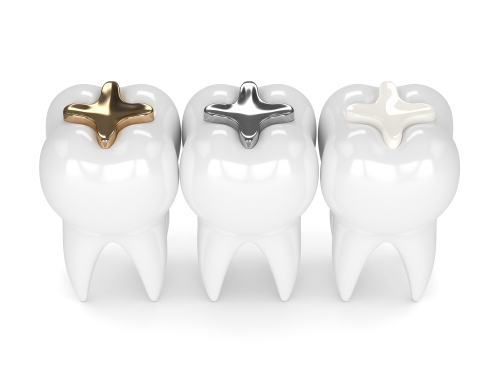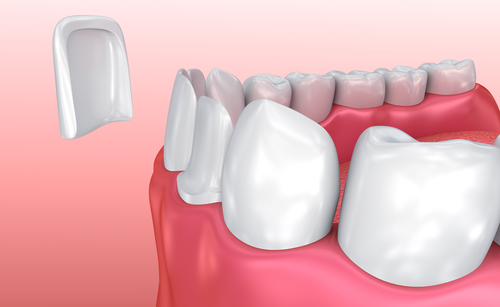Frequently Asked Dental Questions
Most patients want all the facts before making a decision concerning dental work. That’s why we encourage you to browse through this section – reading articles and looking at pictures – to gain a better understanding of any procedures recommended in our office. After all, we know that understanding your treatment needs will help you to be comfortable in making informed decisions.
If you have any unanswered questions, call us at 501-455-6100 We’d be happy to give you further explanation or schedule an appointment for a consultation with our doctors!
What are natural-looking fillings?
Cavities, resulting from tooth decay, have to be filled. And it used to be that they had to be filled with a dark, noticeable filling. But not anymore! We offer the latest in tooth-colored fillings, so the only thing you see is a healthy smile.
Tooth decay is caused when plaque, a sticky layer of bacteria, mixes with sugars in food to form a corrosive acid. And, as everyone knows, decay leads to cavities.
To repair a cavity, the area of decay must be drilled out and the surrounding tooth shaped to receive a filling. Types of fillings include a metal alloy called amalgam and a tooth-colored composite material. Composite is by far the most natural and will be virtually unnoticeable by you or anyone else who happens to check out your pearly whites.

The picture demonstrates an image of teeth that have been filled with gold, amalgam, and composite. On the right, you will see the natural appearance of the tooth that has been restored with a tooth-colored composite material.
A variety of factors determine the lifespan of a filling, from the location of the filling to the level of oral hygiene of the patient.
Call us today at (501) 455-6100 for more information about cavities and fillings or click here to request an appointment!
What are sealants, and why should my child get them?
The chewing teeth in the back of the mouth, which are full of tiny grooves and crevices, are especially prone to cavities. But dental sealants can be used to protect tooth enamel from the ravages of plaque, thereby preventing cavities altogether.
Your teeth are covered with a sticky film of bacteria, called plaque. Plaque bacteria use sugar and starch in food as a source of energy. The bacteria convert the sugar or starch into harmful acids that attack tooth enamel. Repeated attacks may cause the enamel to break down, resulting in cavities.
A sealant is a plastic material that is usually applied to the chewing surfaces of the back teeth-premolars and molars. The depressions and grooves (pits and fissures) of the chewing surfaces of back teeth can be extremely difficult to keep clean. Some of the pits and fissures are so narrow and deep that the bristles of a toothbrush cannot reach into them. These areas are snug places for plaque and bits of food to hide and are especially prone to decay. The sealant – a plastic resin – bonds into the pits and fissures and acts as a barrier, protecting enamel from plaque and acids.
It usually takes only a few minutes to seal each tooth. The teeth that will be sealed are cleaned, then the chewing surfaces are conditioned to help the sealant adhere to the tooth. The sealant is then ‘painted’ onto the tooth enamel, where it bonds directly to the tooth and hardens. Sometimes a special curing light is used to help the sealant harden.
As long as the sealant remains intact, the tooth surface will be protected from decay. Sealants usually last several years before a reapplication is needed. During your regular dental visits, your dentist will check the condition of the sealants and reapply them when necessary.
The likelihood of developing pit and fissure decay begins as soon as the back teeth erupt, so children and teenagers are obvious candidates. But adults can also be at risk for this type of decay and can benefit from sealants as well. Ask your dentist whether sealants can put extra power behind your prevention program.
Call us today at (501) 455-6100 for more information about dental sealants or click here to request an appointment!
Article from copied from Sealants: Know How. Copyright 2002 American Dental Association.
What is Periodontal (Gum) Disease?
Periodontal disease, or gum disease, is responsible for 70% of all losses of permanent teeth and afflicts as many as 9 in 10 adults at some point in their lives. The good news is that gum disease is treatable, even in the advanced stages.
If your gums are puffy or bleed after you brush, gingivitis may be the culprit. Any bleeding from your gums should be a red flag. Make sure you’re doing a thorough, but gentle, job of brushing and flossing. If bleeding persists, don’t wait for your scheduled check-up – come in for an evaluation.
Plaque build-up causes superficial inflammation of the gums. If plaque isn’t removed, the sensitive gum tissues react as they might to a splinter – by drawing away. This creates “pockets” where bacteria lodge, create infection, and begin to erode the tissue that connects gums and teeth. If periodontal disease isn’t checked, the pockets deepen. Eventually, the bone around the roots is destroyed – and the affected teeth follow.
But there is a bright side! Every day, dental science is finding new ways to solve this problem through periodontal therapies and localized antibiotics like Arestin. Since every stage of the disease can be treated, our practice has helped many patients save their teeth and bring their gum tissue back to health and vitality. So, if you suspect gum disease is at work in your mouth, call immediately and let us help you get back on track to a healthy smile.
Call us today at (501) 455-6100 for more information about gum disease or click here to request an appointment!
I need a root canal. What should I expect?
When the nerve in a tooth is infected, a root canal is often necessary. A root canal is a procedure used to treat a potentially excruciating problem.
Decay, fracture, or other injury to a tooth can cause the nerve in a tooth to become infected. If a root canal has been recommended, you need to act quickly. The damaged nerve has a good chance of becoming infected and, as the abscess sets in, you’re facing the toothache of your life. Even worse, the tooth will be lost without treatment.
To perform a root canal, we start by making an opening in the tooth and then we clean inside the root to remove the damaged nerve or pulp. This may take more than one appointment, depending on the curvature of the canal. When we’re satisfied it’s free of debris, we fill the tooth with a natural, rubber-like substance and seal the tooth. Finally, we cast impressions for a permanent restoration (crown) to protect the tooth. Your tooth is now “non-vital” – without nerves, but still nourished by surrounding tissues.
If the tooth is found to be abscessed, meaning the pulp has died and infection has entered the bone, the infection may have to be treated before the root can be filled.
Many people are afraid that a root canal will cause them terrible pain, and therefore delay the procedure. But rest assured that your mouth will be numbed during this procedure. In fact, delaying a needed root canal can lead to unnecessary pain and further damage to the tooth.
Call us today at (501) 455-6100 for more information about root canal therapy or click here to request an appointment!
What is a crown?
Ugly, damaged teeth are nothing to smile about. That’s why we offer crowns to restore your smile and self-confidence. It’s the perfect way to cover teeth with severe decay or damage, or those with cracks, chips, or excessive wear.
To ensure a precise fit, an impression of the tooth to receive a crown is made and sent to the lab as a model. You will be fitted with a temporary crown, placed over the tooth, until the permanent crown is available. During your next visit, the temporary crown will be replaced with the newly-crafted crown, which will be cemented to the tooth.
There are a variety of materials available for use in crowns, and the crown lifespan may vary accordingly.
Please feel free to contact our office to discuss your options. Call us today at (501) 455-6100 for more information about crowns or click here to request an appointment!
I am not sure I understand what implants are. Please explain.
For the right candidate, implants offer a more functional and secure method for tooth replacement and/or denture support. With dental implants, you’ll feel like you have the real thing again.
The procedure for placing a dental implant happens in three stages. First, the implant device is inserted into the upper or lower jawbone. This procedure is surgical, and is usually performed with local anesthesia or a combination of other types of sedation. After a healing period from two to six months, posts are attached to each implant. (During this time you won’t be “toothless” – we’ll have temporary replacements for you.) Finally, new teeth are made to the unique specification of your face and mouth, and secured to the implanted posts with precision attachments. Only the “tooth part” will be visible.
What makes a successful implant? In our system, it’s Osseo integration – the meshing of implant and bone. A chemical and mechanical bond is formed, allowing the jawbone to actually grow into the implant. To be considered for an implant, you will need to start with an overall healthy mouth and demonstrate excellent oral hygiene to ensure proper maintenance of the implant.
One of the many benefits of implants – aside from a more comfortable, natural-looking smile – is that they will not shift or slip in your mouth. Whether you have individual teeth, dentures or bridges mounted on your implants, you can be confident when speaking or eating, knowing that your dental work is stable and secure.
Due to the extensive dental work and time required, dental implants can be costly, but they are often the next best thing to your natural teeth. Patients should consider the investment and benefits, then decide if permanent implants are the answer for a healthy, attractive smile.
Call us today at (501) 455-6100 for more information about dental implants and how they can improve the function of your teeth and give you a beautiful smile or click here to request an appointment!
I want to straighten my teeth, but I don’t want the hassle of braces.
Is there another option?
If you’ve considered braces, but dread a silver smile, then the new Invisalign® system could be perfect for you!
Invisalign® is an exciting new alternative to braces that uses a series of clear aligners to gradually straighten your teeth over time. These aligners – or repositioners – are practically invisible, easily removable, proven effective, and comfortable to wear. Harris, Reynolds & Cason Family Dental in Little Rock offers Invisalign®.
The Invisalign® system uses advanced 3-D computer imaging technology to project the movement of your teeth over time. With this information, a series of clear, custom aligners are created to gradually adjust your teeth. Each aligner is worn for about two weeks, then replaced with the next aligner in the series.

Because they are easily removable, the aligners do not require any lifestyle changes. Patients can continue eating and drinking normally, and no oral hygiene adjustments are necessary. Unlike traditional braces, Invisalign® uses no metal, brackets, or wires. Not only does this make for an attractive alternative, but it also makes Invisalign® a much more comfortable option than braces.
Call us today at (501) 455-6100 for a consultation or click here to request an appointment!
What are Veneers?
Porcelain veneers, or laminates, are a “treatment for all seasons” that correct many types of cosmetic problems – covering discolored teeth, lengthening teeth, mending chips, and even hiding spaces between teeth. They’re that versatile!

Here, you can see the dramatic difference in the smile of a patient who chose to correct misshapen, crooked, and stained teeth with porcelain veneers.
To prepare for porcelain veneers, we begin with a functional and esthetic evaluation to determine what shape and contour are best for you. We may opt to prepare about .5mm of the tooth structure to “receive” the veneer. Then we’ll take an impression and send it off to the lab for fabrication. You will wear temporary veneers that look close to the real thing while your permanent veneers are being made.
From our impression of your teeth, the lab casts a model and begins to build the veneers in layers. On your next visit, we’ll examine the color and shape of the veneers before we place them. Then we’ll clean and chemically etch your front teeth, which helps create the bond between tooth and veneer, before cementing the veneer in place and curing the seal with a special light. We’ll double-check the fit, then polish your new veneers.
Once this process is complete, all you’ll notice is a new, beautiful quality to your smile!
Call us today at (501) 455-6100 for more information about veneers or click here to request an appointment!

Family Dentist in Little Rock
Contact us & plan your visit
VISIT US AT
Harris, Reynolds & Cason Family Dental in Little Rock
Address
9801 Stagecoach Rd. Little Rock, AR 72210
Office Hours
Monday, 8:00 a.m. – 5:00 p.m.
Tuesday, 7:00 a.m. – 5:00 p.m.
Wednesday, 8:00 a.m. – 5:00 p.m.
Thursday, 7:00 a.m. – 3:30 p.m.
Fridays, 8:00 a.m. – 1:00 p.m.